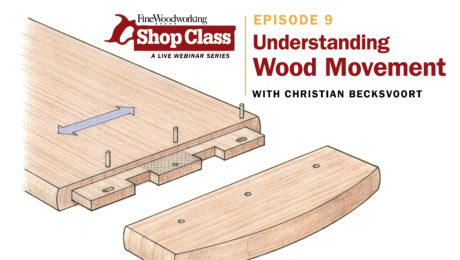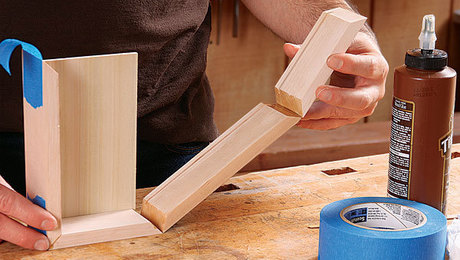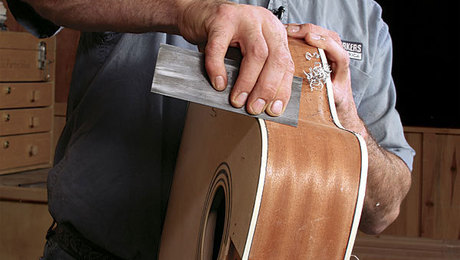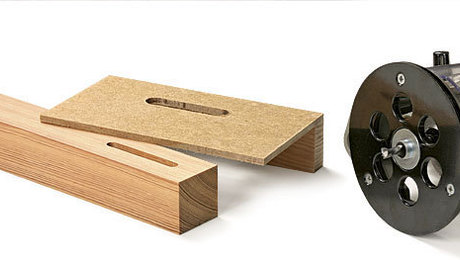STL225: Just use the plywood already!
Anissa, Barry, and Ben give a pep talk to a listener worried about stepping up to walnut and another listener who is doing everything he can to avoid using plywood.Question 1:
From Scott:
I’ve been making stuff for as long as I can remember. I work as an electrician and I feel as though I have a good sense of detail and craftsmanship. I’ve been woodworking for about a year, mostly on pine and poplar as I’m budget conscious. I’m getting 2- 1.5×10 ft 8/4 live edge boards of walnut for 20$. And don’t want to waste them. When do I step up to higher end wood??
Question 2:
From Matt:
After many hours of battling with my wife I have found a design I think we both can live with. My wife gave a little ground and is willing to let me build the bed, and nights stands shown in Michael Cullen’s Contemporary Arts and Crafts Bed article.
There are however two obstacles we need to overcome.
1) Katie LOVES the nightstands shown in the article photos. I have done a bit of digging but unfortunately I can’t find plans for these night stands. Hopefully there is something out there you can refer me to that will at least get me going in the right direction. If not I can probably cobble something together. I just hate the idea of making a mistake and wasting walnut at $9.50 bf.
2) The Bed is primarily made from veneered panels.
I understand that sheet goods allow more flexibility in design because they are far more stable, but I kinda hate them. I know it’s stupid, but I can’t help it. Is there a construction method that I could use that would not dramatically change the look of the headboard, and footboard? I think that I could get away just a typical panel glue up but wouldn’t have the same control over the grain pattern. I live in an area that has pretty dramatic swings in humidity so wood movement could be a problem. Do these panels need to be treated any different than a table top?
 |
Contemporary Arts and Crafts BedUpdated design combines solid walnut with veneered panels |
 |
|
 |
Free Plan: Mid-Century Modular Wall UnitAnissa Kapsales’s wall-unit features mitered cases combined with a unique hanging system for versatile storage |
 |
Webinar: Understanding Wood Movement with Christian BecksvoortReplay Join FWW contributing editor Christian Becksvoort for our webinar on wood movement. |
Segment: Potpourri
Barry – Favorite tool: Hide glue
 |
|
 |
Ben – Using hot-melt glue to flush up a tablesaw throat plate
Anissa – Smooth Move: Forgetting to put styles in before installing a face frame
Question 3:
From Jesse:
Please ramble about how cool getting into lutherie has been. What have been some of your favorite resources for learning lutherie stuff? Any particular books or VHS collections?
 |
|
 |
FWW Index page – Our favorite resource for finding esoteric articles on the website.
Making an Archtop Guitar Paperback by Robert Benedetto – Decent book but you couldn’t possibly build a guitar using just this book
Question 4:
From Clay:
I’ve been getting into woodworking for the past year. I’ve built up a small shop in my garage with a table saw, miter saw, sanders and routers, and a drill press.
My wife wants me to build us a new farmhouse style trestle table. The base will be made up of 4×4 center legs with 1” thick X-braces. I have never cut a mortise and tenon, I don’t have the budget for a domino, and I don’t want to build a table that will crash to the ground with a thanksgiving feast on it! I’ve attached a picture of the style I’m going for, and I’m mostly concerned about how to attach the X brace pieces to the center legs. I have a doweling jig, but I don’t know what size I should use, and will that be strong enough? Using biscuits doesn’t seem like that would provide enough strength, but maybe I’m wrong.
 |
Modern Adirondack ChairTom McLaughlin builds a comfortable, contemporary take on the backyard classic |
 |
|
 |
|
Listener Comments:
From Mike:
Love the show! I feel compelled to write to you because, just moments ago, I experienced my first ever kickback event. Yikes! In fact, it happened while listening to episode #220, not long after a lengthy discussion on kickback in response to a listener question and Barry’s comment about needing to respect the “weird physics” of a table saw. Now I have egg on my face, but luckily no lasting injuries. I think the initial impact occurred on my hip right where my belt is so there were several layers of material to cushion.
I consider myself super cautious at the table saw and have never done anything this stupid. The small 12″ x 3.5″ board I had just ripped got hung up mid-cut because the throat plate had slipped a little below the height of the table. I wiggled it through safely, then decided to use the edge of the just-cut board to run along the throat plate to get it to bump at the table (to verify that that was the problem), and somehow managed to let go of the board, dropping it onto the blade WHICH I HAD LEFT RUNNING. Yes. I realize how ridiculous this sounds from someone who just described themselves as super cautious at the table saw. I was definitely not giving 100% attention to the task at hand (which was another thing Ben discussed in that episode). For my own good, I will henceforth reserve listening to Shop Talk Live only while driving, sitting quietly, or during hand work. Thanks for reminding us that we all need reminders on safety, even when we think we are super cautious
Mike
Recommendations:
Anissa – You’re wrong about podcast
Ben – Ear Hustle podcast
Barry via Mike Korsak – Winds of Change podcast
Every two weeks, a team of Fine Woodworking staffers answers questions from readers on Shop Talk Live, Fine Woodworking‘s biweekly podcast. Send your woodworking questions to shoptalk@taunton.com for consideration in the regular broadcast! Our continued existence relies upon listener support. So if you enjoy the show, be sure to leave us a five-star rating and maybe even a nice comment on our iTunes page.




















Comments
Michael Cullin’s nightstand is wonderful. Wish my home needed one at the moment as I’d love to build it! Very fun podcast this week guys!
Annisa, can you use pocket screws for the stiles?
Yes, Just use the plywood. Buy something nice and get the bed built.
Definitely build an instrument. Fifteen years ago I bought a book on making electric guitars on Amazon. Can't remember the name but it included a section with detailed notes for at least 5 instruments including a short string base. I built the latter for my daughter out of a selection of Australian hardwoods I'd been hoarding since 1988, the year she was born and the year we moved home from Melbourne. Although she only took lessons for 3 years it is still one of her prized possessions.
At the time my shop had a Sears contractor saw, home built router table and an electric jig saw and a poorly sharpened block plane, but a really good ruler for laying out the fretboard. I'm tone deaf and the music teacher didn't wince when he turned it up, or for a couple of years of lessons after that.
I bought all the hardware by mail from Stewart Macdonald, nice stuff. I'll send an attachment photo later if I can find one.
Another source for both Luthier inspiration and information is Rosa String Works. Jerry Rosa builds and repairs stringed instruments of all types out of his Missouri farm. As Ben noted, "it's just woodworking", and Jerry certainly embodies that spirit in his videos as well. However, being a luthier and a Bluegrass musician Jerry also includes comments on instrument setup, forces and effects of string tension on instruments and how to compensate for them, and also things that do and don't effect the sound of instruments. His youtube channel (and website) includes music and videos on the repair and construction of guitars, mandolins, and violins:
https://www.youtube.com/channel/UC29Dkc6-RMU8TCrloPN0Cbw
and
https://rosastringworks.com/
Log in or create an account to post a comment.
Sign up Log in